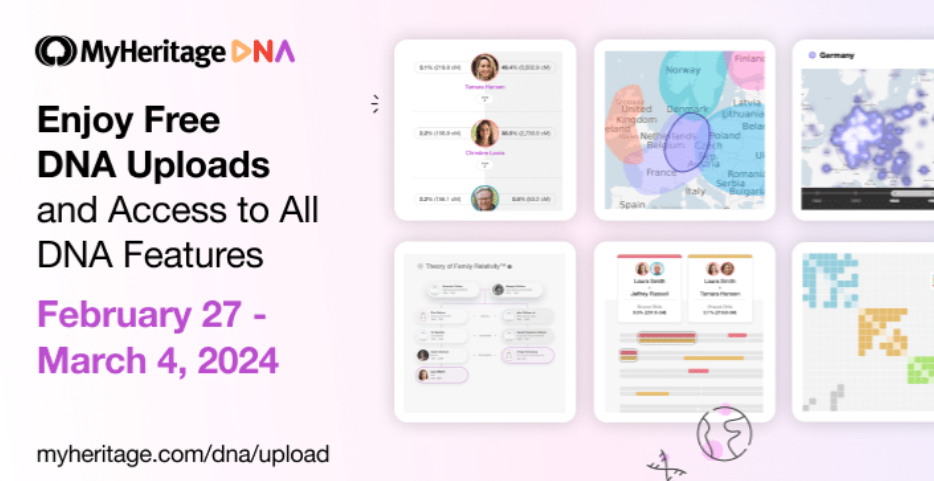Most of the rest of my day was spent with MyHeritage doing various things. I attended a talk by Gilad Japhet, Founder and CEO of MyHeritage. He introduced several new and upcoming products that MyHeritage users will be able to use for their research. Currently MyHeritage has nearly 20 billion records available for your research. Recent features that have been added since RootsTech 2023 included the Photo Dater, AI Biographer, and AI Record Finder. Photo Dater uses AI to give an estimate of the year a photo was taken. The AI gathers information from multiple items within the photo including clothes, furniture, vehicles, etc. to build the estimate. Over 5 million photos have been dated since the product was introduced. AI Biographer creates detailed biographies by exploring your tree as well as other tress where the person is included, records, and other internet sources to gather data. Over 115,000 AI Biographies have been written in the last 2 months. These biographies are in pdf format and are attached to the tree and can be downloaded for your use. The third recent release is the AI Record Finder. This product is the first AI search engine specifically designed to find historical records for your genealogical research. The search is based on AI chat and can be built upon by adding more or less information in a series of questions or requests. Over 500,000 search messages have been requested in the last 2 months.
This week, until March 4, you can upload your DNA data file to MyHeritage from another service and get FREE access to all advanced DNA features, including the Ethnicity Estimate, forever! Click this link to learn more.MyHeritage released several new products during RootsTech. One is the new Profile Page with hints. This profile page puts all the important information in one place including life events, saved records, immediate family, life map, consistency checks, and hints. The hints are located under each event so you will find hints that can improve birth information directly under the birth information and so on. The Profile Page has a new Biography tab where you will find the AI Biographer, basic biographies based on the records, and biography notes that you can write and edit. There is also a Photos tab where all of your photos and uploaded records are stored, and a DNA tab where your DNA results can be found.
MyHeritage also announced the release of OldNews.com. It currently has over 20 million pages from eight countries and is in 11 languages. The current countries represented include the US, Canada, UK, Australia, Netherlands, Germany, Austria, and Czech Republic. More countries including Hungary and France and several more languages will be added soon. They expect to add over 100 million newspaper pages per year in the coming years. MyHeritage is using AI extraction to gather data from obituaries during the initial release of these records. OldNews is a standalone newspaper archive which can be added to your MyHeritage account by upgrading to the Omni level or subscribed to separately. The MyHeritage Omni subscription will include MyHeritage Complete, Geni Pro, FamilyTree Webinars, OldNews and some other benefits. You can test OldNews out with a 7-day free trial.
MyHeritage is upgrading their MyHeritage app by incorporating their Reimagine app technology. The new app will have all the same functionality allowing you to automatically crop individual photos from pictures of album pages and identify faces.
In addition to all this news, MyHeritage hinted at some upcoming releases. MyHeritage and FamilyTree DNA will be collaborating to allow FamilyTree DNA users to access the MyHeritage trees when looking for DNA matches and also link their DNA accounts between the two platforms. This should happen later this Spring around April-May. MyHeritage will also add the capability to securely share your DNA results with another person or researcher so they can have more detailed access and help you find lost relatives. This will be available near the end of March. Later this summer, sometime around June, MyHeritage will release their updated ethnicity results. This will increase the ethnicity groups from 42 to 80 and provide users more detailed resolution.
MyHeritage is also trying to scale up archival DNA so it can become part of the DNA products they offer. This is still a little way off but they are excited about the potential to extract DNA from artifacts such as postage stamps.
I also was able to have several one-on-one interviews on Friday. You can see the 10-minute videos at the links below.
I spoke with Aaron Godfrey, Vice President of Marketing at MyHeritage. We talked about how MyHeritage markets its products to its various audiences.
I spoke with Daniel Horowitz, MyHeritage's Genealogy Expert about the new products that MyHeritage has released.
I also spoke with Tina LaFreniere, Founder, CEO and CPO of Related Faces. Related Faces is a startup which helps you identify your unknown photographs.
 |
| MyHeritage Friends Social |
Another great day at RootsTech!



